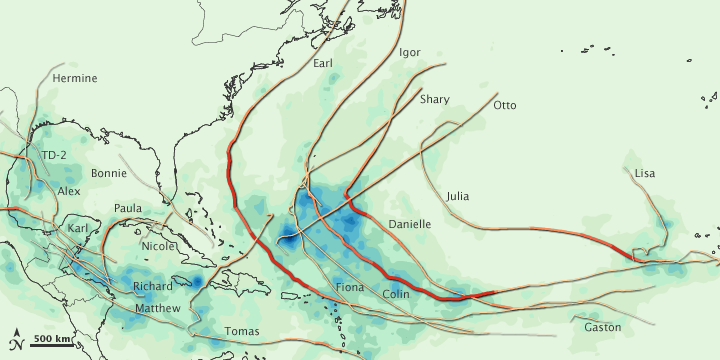


November 30 marked the end of the 2010 Atlantic hurricane season. Throughout the season, nineteen named storms formed over the basin, making it the third most active season on record, tied with 1887 and 1995. Twelve of those storms became hurricanes, and five of them became major hurricanes (Category 3 or higher). It was the most active season since the record-breaking 2005 season. (For a comparison between the two seasons, see the TRMM web site.)
This image shows the paths taken by the storms and the rainfall associated with each storm throughout the season. The rainfall measurements are from the Multisatellite Precipitation Analysis, which is based on data from the Tropical Rainfall Measuring Mission (TRMM) satellite. Although most of the major storms missed the continental United States, curving back out to sea instead, hurricanes and tropical storms did major damage to Haiti, eastern Mexico, and Central America.
Multiple hurricanes formed around Cape Verde, off the west coast of Africa. Small areas of significant rainfall appear in that region. Expansive areas of intense rainfall occur over the open waters of the Atlantic Ocean, and these high rainfall amounts correlate to areas where storms curved back to the east, stopping short of reaching the continental United States.
Significant rainfall also appears over the Caribbean Sea and Central America. Hurricane Alex brought heavy rain to parts of Mexico and Central America. Hurricane Earl caused heavy rain and strong winds along the coast of the northeastern United States. Hurricane Tomas soaked Haiti.
In the wake of the Deepwater Horizon oil spill, many Gulf Coast residents worried about the potential impact of hurricane activity. Only one storm, however, impaired cleanup operations. Hurricane Alex caused a five-day delay.
Multiple factors played a role in the 2010 hurricane season activity. Tropical storms and hurricanes derive energy from warm ocean surface waters, and the Atlantic Ocean experienced record warmth, according to the U.S. National Oceanic and Atmospheric Administration (NOAA). Favorable winds off Africa and weak wind shear conditions influenced by La Niña all contributed to storm development.
The storm activity that unfolded over the 2010 Atlantic hurricane season was within the range predicted by NOAA (14–23 named storms, 8–14 hurricanes, 3–7 major hurricanes predicted on May 27). An average season in the Atlantic basin experiences 11 named storms, six hurricanes, and two major hurricanes.
NASA Earth Observatory image created by Jesse Allen, using TRMM MPA data provided courtesy of Hal Pierce, and storm track information from Unisys Weather Hurricane/Tropical Storm Data. Caption by Michon Scott.